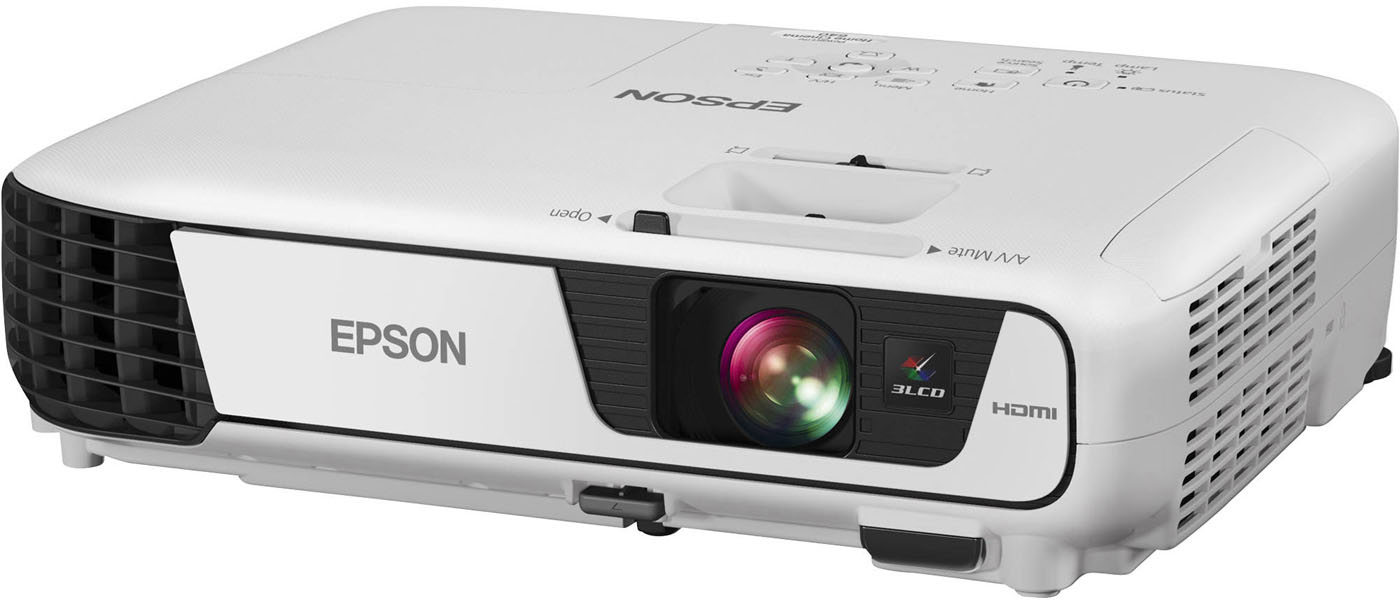The H9090 is a single-chip DLP model with a 0.95″ DMD and an RGB-LED light source which means no color wheel and no rainbows for the small number of viewers affected by the phenomenon. Interchangeable lenses and generous lens shift makes installation flexible and easy. And it’s packaged in one of the sturdiest cases I’ve ever see with superb optical quality and a very bright picture.
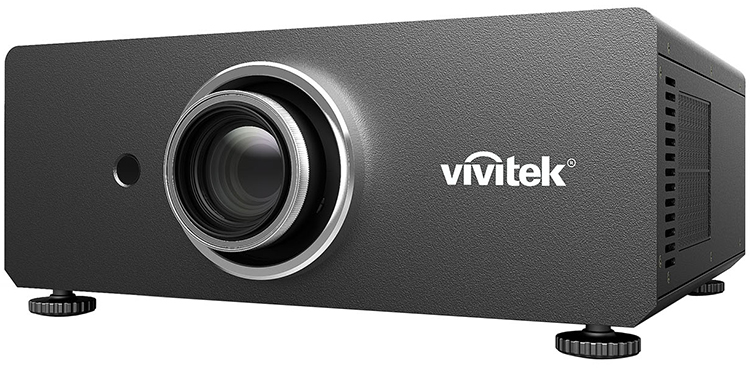
Vivitek H9090 LED/DLP Projector
- Four lens options for installation just about anywhere
- Generous lens shift
- Very bright
- Optical quality without peer
- High-end Gennum video processing
- Flexible calibration options with full color management and four settings memories
- Inputs for every conceivable source both digital and analog
- Control via IR and RS-232
Though Vivitek is a large and well-established projector maker, I have not had the opportunity to work with one of their products until now. After the 2015 CEDIA Expo in Dallas, I was offered a review sample of the H9090 LED/DLP home theater projector, which I gladly accepted.
Light Engine:
Single-chip .95-inch DLP w/RGB LED
Native Aspect Ratio:
16:9
Native Resolution:
1,920 x 1,080
Anamorphic Lens Support:
Yes
Lens Options (throw ratio):
Fixed (.73:1), Short Zoom (1.56-1.86:1), Standard Zoom (1.85-2.4:1), Long Zoom (2.4-4.0:1)
Lens Shift:
± 120% Vertical, ± 30% Horizontal
Light Output:
1,000 Lumens
Contrast Ratio:
100,000:1
Inputs:
2 x HDMI 1.3, 2 x Component, 1 x Composite, 1 x VGA, 1 x S-Video
Control:
2 x 12V Trigger, 1 x RS-232, 1 x IR Input
Rated LED Life:
20,000 Hours
Dimensions:
6.4″ H x 16.25″ W x 16.5″ D
Weight:
28 Pounds
Warranty:
5 Years
MSRP:
$9,999 USD
Company:
SECRETS Tags:
Vivitek, H9090, Vivitek H9090, LED/DLP Projector, Projector Reviews
You’ll recall that a few years ago, LED engines first appeared on the scene and promised to replace the UHP lamp as front projection’s principal light source. Unfortunately the price of admission has yet to drop enough for this to happen. When companies like Epson can market LCD models with superb image quality and prices under $3000, a $15,000 LED display becomes a hard sell to most home theater enthusiasts. Even with the money you’ll save in bulb replacements, the economics are undeniable.
LED projectors are still at the upper end of the price scale but recent models like Optoma’s HD91+ (which won a Secrets Best Of 2015 Award) have brought the cost down substantially. At $9999 MSRP the H9090 isn’t exactly cheap but progress is being made.
Secrets Sponsor
LEDs promise not only long life but color and brightness stability as well. UHP lamps degrade as they age and some projectors (like my Anthem LTX-500) require a fresh bulb every 1000 hours or so. Their only real flaw has been low light output. They just can’t quite reach the 40-50 foot-Lambert level we’re seeing in many compact LCD and DLP models. The H9090 however changes that perception. My review sample put out an impressive 41fL peak through some seriously fine optics and impressed me from the moment I unpacked it. Let’s take a closer look.
The light engine uses a single .95” DLP chip from Texas Instruments. It’s capable of 1920×1200 resolution which makes it suitable for use as a computer monitor in the 16:10 format. The LED source is the latest generation PhlatLight (PT-120) solution and employs red, green and blue diodes eliminating the need for a spinning color wheel. Rated power is 1000 lumens which is an honest claim according to my measurements. I saw over 40fL after calibration in my tests.
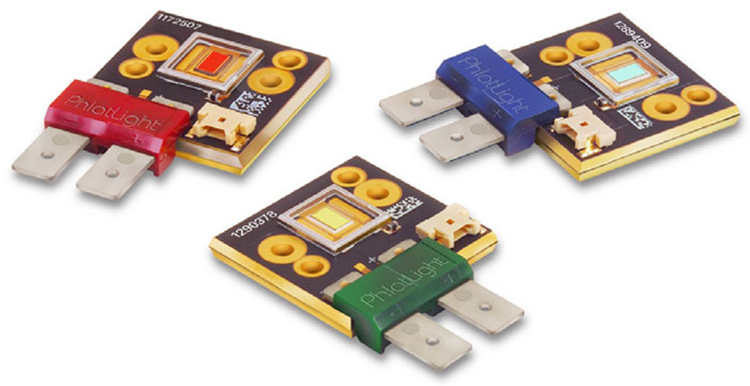
In the photo above you can see the diodes on each circuit board. They are 12 square millimeters and can power DLP, LCoS and LCD displays. Power consumption and output depend on application but in the case of the H9090 they consume around 175 watts in typical operation.

The lens is of extremely high quality and is interchangeable. Four options are available – three zoom lengths plus a fixed version for short throw applications. It has manual focus and zoom adjustments which feel like those of a high-end camera lens. There is no play whatsoever and resistance is just right being neither too firm nor too loose.
Secrets Sponsor
The chassis is professional-grade all the way with a full metal enclosure and a simple box design. Corners are gently rounded to prevent any sharp edges or corners. The only distinguishing feature is a large Vivitek logo on top which comes off to reveal the lens shift controls. These are manual as well and operated with the included Allen key. You get a generous 120-percent vertical shift in both directions and 30-percent horizontal. This is the most adjustment I’ve seen in any DLP to date. Aligning the image on the screen took me all of five minutes thanks to these extremely precise and well-engineered controls. If you need to level the H9090, there are four independently-adjustable feet on the bottom.
Heat management is handled by large vents on either side, one for intake and one for exhaust. You can see large fans behind the grills. Despite their size they are very quiet, rated at 25dB. I had the projector right behind my head when viewing and could not hear the fan unless there was no other sound in the room.
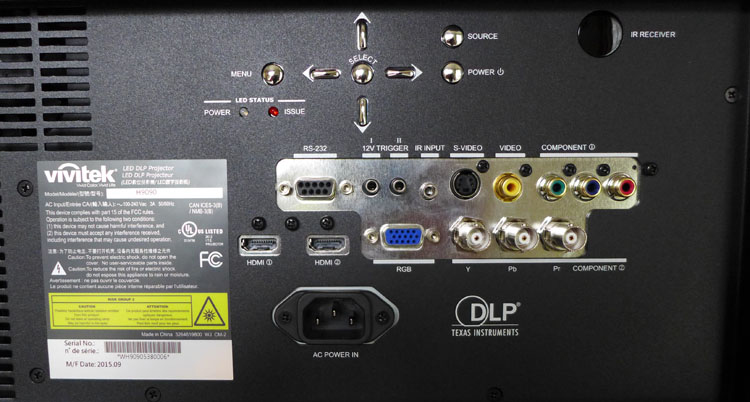
The input panel is loaded with every kind of video connection you could ask for. In addition to two HDMI 1.3 ports there are two component inputs, one of which uses BNC connectors. These are an extremely secure bayonet-style plug normally found only on high-end video displays. If you need to hook up a computer, Vivitek has provided a VGA port. Rounding out the jack pack are composite and S-Video hookups. For control purposes there’s an IR input, two 12v trigger outputs and an RS-232 port. Also around back are basic controls for menu navigation, source selection and power.
The remote is backlit with a soft red light that’s ideal for darkened theaters. It won’t dazzle the eyes like some of the blue lights I’ve encountered. At the top are discrete power keys followed by five programmable inputs selectors. In the middle is menu navigation with three settings-memory controls after that. At the bottom are keys that directly access functions like brightness, contrast and other image adjustments.
The OSD is divided into six sub-menus, the first two of which contain all the calibration controls.
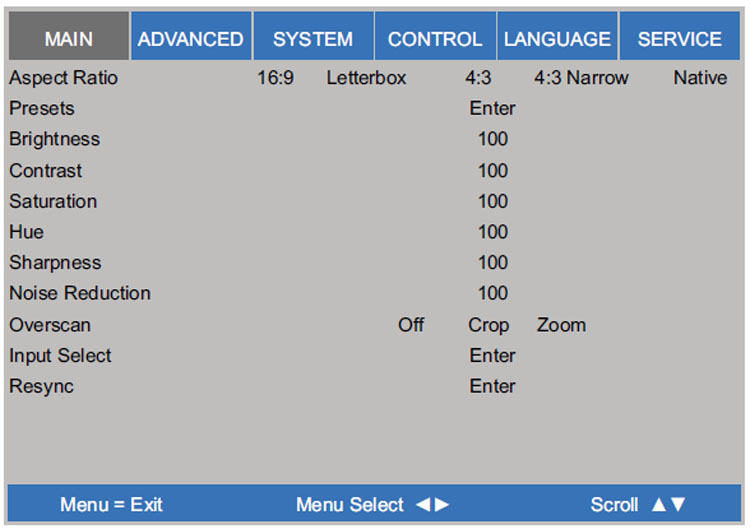
Anamorphic lenses are supported in the Letterbox mode. Presets takes you to a second screen that allows you to save your settings in four different memory slots. I much prefer this approach to picture modes. Brightness and contrast adjust the black and white thresholds as you’d expect but use the contrast control carefully. At its default setting, it clips green making it difficult to set the white balance properly. Saturation and Hue are grayed out for digital signals but there is a full color management system available.
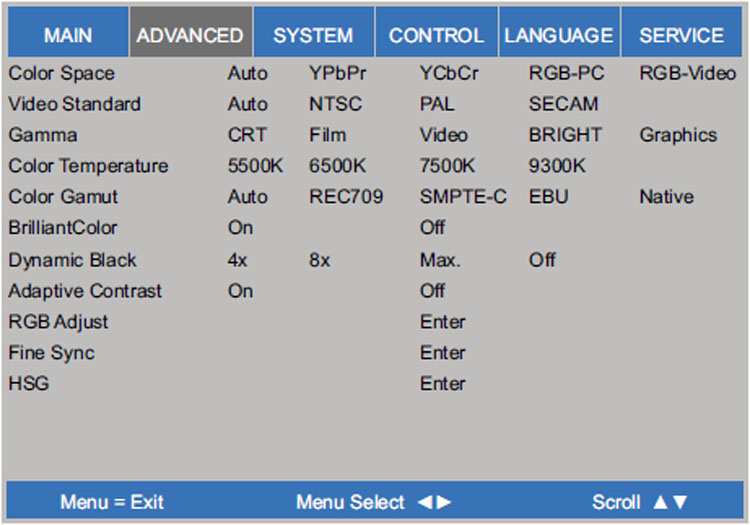
This menu is similar to the advanced section of many displays. Here you can select a color space, video standard, gamma curve, color temp and color gamut. Speaking of the latter, the only way to access the CMS (called HSG here) is by selecting Native. The other presets are not adjustable. The color temp however can be tweaked regardless of the chosen gamut.
Image enhancements include Brilliant Color, Dynamic Black and Adaptive Contrast. I’ll talk more about them in the next section.
To perform the calibration I started in the 6500K color temp mode and the Native color preset. This gamut is extremely wide, exceeding even the Adobe RGB standard. The CMS works very well with hue, saturation and gain controls that don’t interact. I was able to get the color points right on target but a few minor issues cropped up that I couldn’t fix. More on that in the benchmarks.
To install the projector I placed it on a rack at about center-screen height. I lined everything up with the generous lens shift adjustments then connected my pattern generator and an Oppo BDP-93 Blu-ray player. After completing the calibration I sat back to watch a few movies.
I could see just from the initial setup and calibration that the H9090’s lens quality was a cut above most of the projector’s I’ve reviewed. Not only did test patterns look tack-sharp from edge to edge, there seemed to be a smaller pixel gap than other DLP’s I’ve worked with.
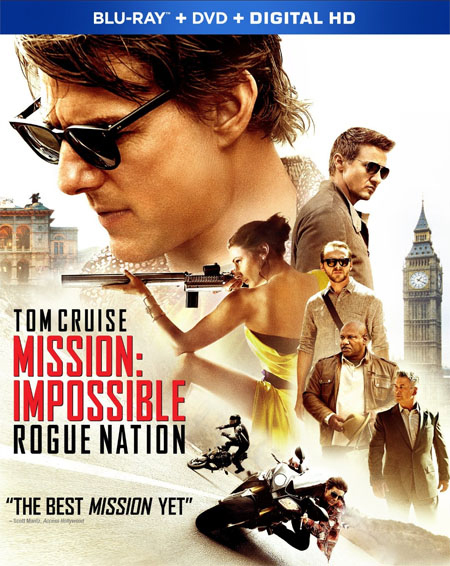
I spent quite a bit of time watching Mission: Impossible, Rogue Nation so I could try various combinations of the Dynamic Black and Adaptive Contrast options. The latter crushed highlight and shadow detail in test patterns but in practice, the effect wasn’t too distracting.
With Dynamic Black engaged, black levels were nice and deep with good detail-rendering but I saw moments of image pumping as the algorithm lagged a bit behind changing content. I finally decided to leave DB off and AC on. This produced a very punchy picture with nice saturated color, tons of razor-sharp detail and no visible artifacts.

The Hobbit, Battle of the Five Armies is one of the cleanest presentations in recent memory. The all-digital Blu-ray transfer has an ethereal quality with equal amounts of intricate detail and beautiful soft-focus textures.
Thanks to the H9090’s excellent optics every nuance was readily apparent. Adaptive Contrast really brought a lot of depth to the presentation. It’s hard to imagine the film looking better. And it certainly exceeds anything one would see in a commercial cinema.

The Man From U.N.C.L.E. is a retro-lover’s feast with a period-correct color palette and a real vintage look and feel. Warm tones like this can often make the image look flat but here it was the opposite. I again enjoyed the effect of Adaptive Contrast as the Blu-ray’s already large dynamic range was expanded even further.
Dark scenes were full of detail though blacks weren’t quite as rich as what I’m accustomed to from my Anthem LCoS projector. That being said, the H9090 still showed me the best contrast I’ve seen from any DLP at any price. And its optics are about as good as it gets.
All grayscale, gamma and chroma readings are taken from the projector’s lens using an X-Rite i1Pro with the diffuser attachment. Contrast tests are done with a Spectracal C6 tri-stimulus meter positioned at the lens axis and measuring from the screen at a 12-foot throw distance. This method provides an accurate picture of the contrast performance seen in a typical viewing environment.
My reference screen is a Stewart Filmscreen LuminEsse fixed-frame system configured with StudioTek 130 material. It has a gain of 1.3 and is 92 inches diagonal in size. Patterns come from an Accupel DVG-5000 signal generator and the whole procedure is controlled by CalMAN version 5. Color standards are Rec.709 with a white point of 6500 Kelvins. Gamma is compared to the BT.1886 spec or the 2.2 power function where appropriate.
Rather than picture modes, the H9090 has four settings memories plus a default preset. That’s where I began my measurements.

The Default mode is based on a color temp of 6500K but clearly it runs a little blue. The error increases with signal level and the brightest whites are the most tinted. With an average error of 5.7635dE, you’ll see the color shift from 40-percent on up. Gamma tracks almost perfectly with only the slightest dip at the 90-percent level. The error is well below the threshold of visibility.

RGB Gains and Offsets are available in every gamut mode and the adjustments carry over to the different presets. The sliders have extremely fine resolution and I was able to get most errors under the two Delta E level. I ran out of green at 100 percent because I chose not to lower the Contrast control too far. To get the error under three means accepting an image with less pop so I compromised. You can barely see a red tint in the very brightest whites but the added depth and contrast is well worth it.
The Default mode is based on the Rec.709 color gamut preset.
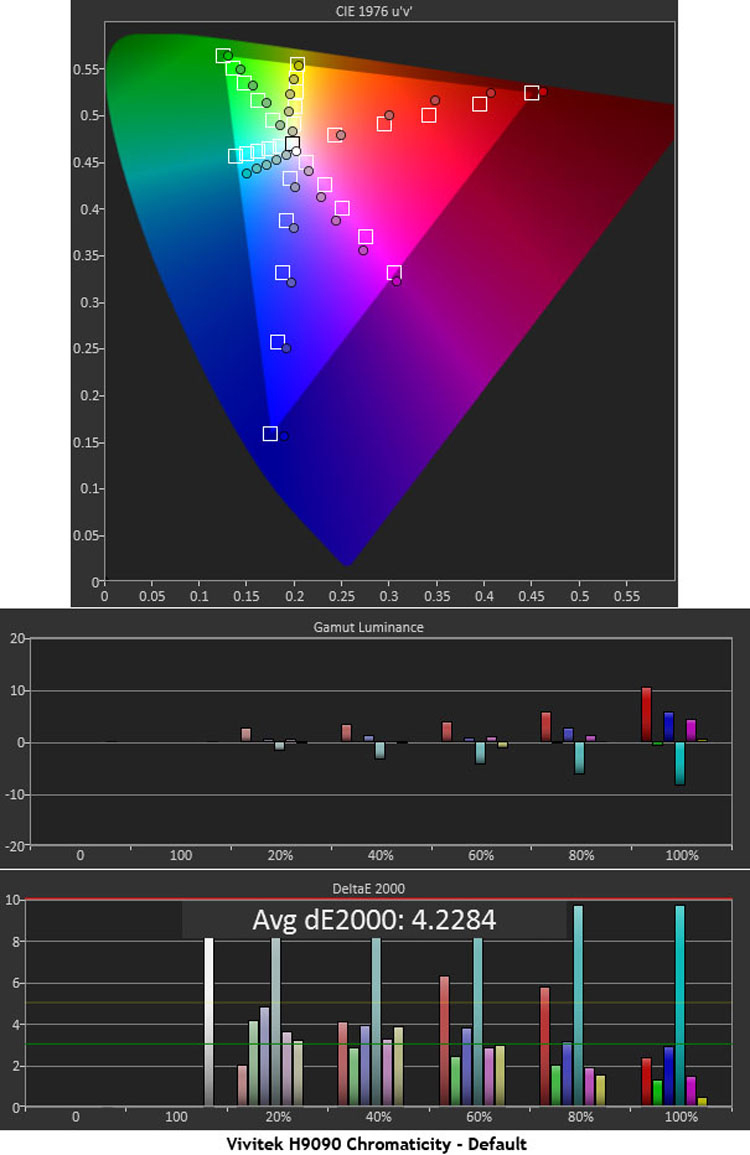
The 100-percent saturation levels are pretty much on-target but there are some issues at the mid-range points. Red and yellow don’t track their hues quite as well as they should. Cyan and magenta are also off in hue but this will be helped by the grayscale calibration.
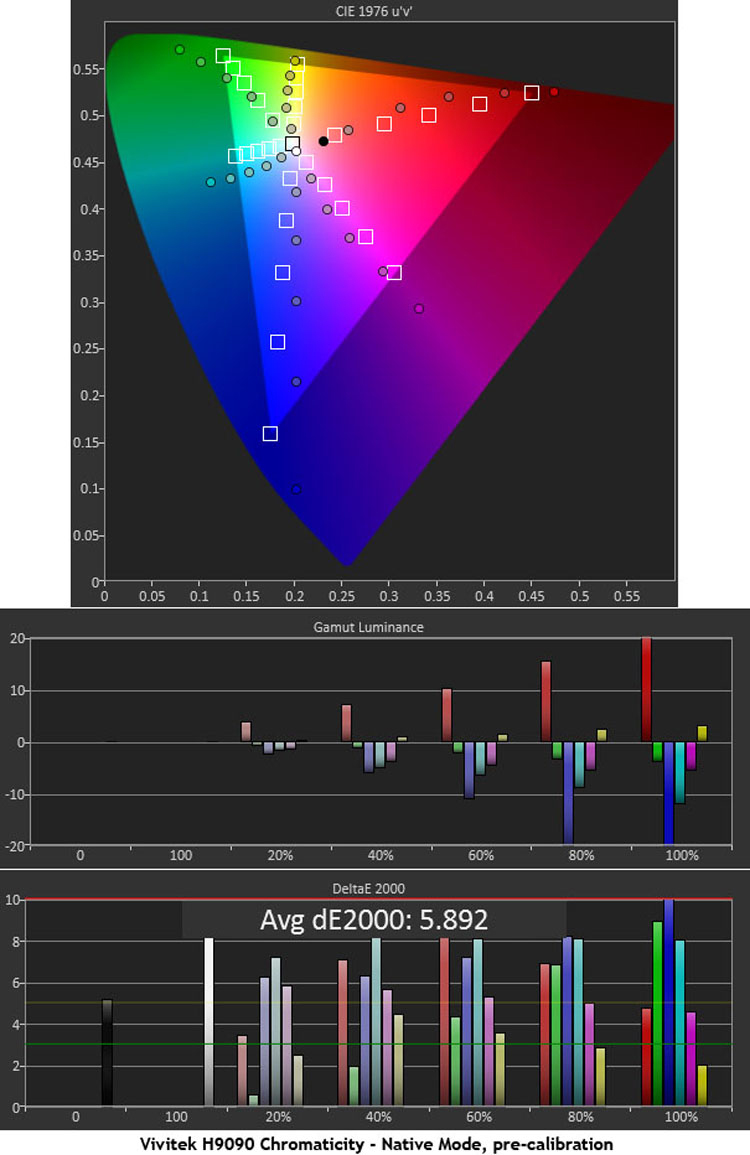
To unlock the color management system, you must select the Native color gamut. Don’t do this unless you have the means to calibrate because the H9090’s uncompensated gamut is quite large. In fact it exceeds the volume of Adobe RGB and Digital Cinema Initiative (DCI) 1.2. While a fair amount adjustment is necessary to achieve Rec.709, the CMS has plenty of color to work with and the controls are very precise.

The hue, saturation and gain adjustments don’t interact which makes dialing in the gamut very easy. The only flaw is the saturation tracking in red, magenta and yellow. To fix this, the H9090 would need a color editor that allows for adjustment at multiple saturation levels. I still achieved decent color accuracy with only a few visible errors in red and yellow. Luminance values are almost perfect which results in a very balanced and natural image.
Initial contrast tests were performed with Dynamic Black and Adaptive Contrast turned off to evaluate the H9090’s native state. There is no LED power control available so output must be adjusted with the Contrast slider. I lowered it just enough to prevent clipping. At that point max white was 38.5926fL, black was .0284fL and the contrast ratio was 1361.2:1.
Engaging Dynamic Black lowers the black level and raises the max white value slightly. In its Max mode white measured 41.673fL, black was .002fL and the contrast ratio was 21,052.3:1. There are pros and cons to this option. The good part is black detail is not crushed at all but the tradeoff is a slight color shift towards red.
The best compromise is to set Dynamic Black on 8x. This results in a white level of 39.5798fL, a black level of .0026fL and a contrast ratio of 15,016.9:1. There is very little color shift and detail is retained properly.
Contrast can be pushed to an infinite level (immeasurable black) by turning on Adaptive Contrast. In some content however you can see clipped detail in the brightest and darkest areas of the image.

Thanks to a high-end Gennum GF9450 chip, the H9090 displays the best video processing I have seen from any display of any type. Variations of this solution have been used in standalone processors as well as Anthem’s flagship D2V surround pre-pro. Aside from a failure in the Mixed Content Vertical test, which seems to be common to every video product on the planet, the projector handled every torture test I could throw at it. When fed a 4:2:2 signal the chroma burst pattern softened a bit but all the lines were visible. RGB and 4:4:4 were pixel-perfect.
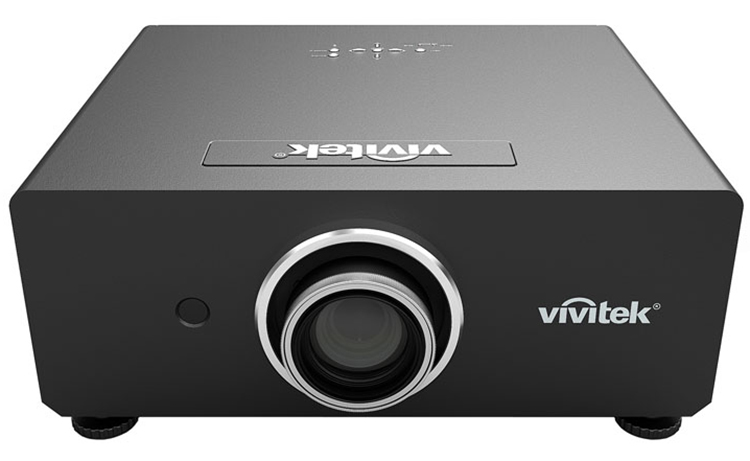
THE VIVITEK H9090 is a bit of an investment but for your money you’ll get tank-like build quality, a superb lens and a clear bright picture with extremely high contrast. It’s the best LED projector I’ve seen to-date.
- Lots of light output
- Sharp picture thanks to superb optics
- Good contrast
- Well-saturated and accurate color
- Build quality second-to-none
- Excellent CMS and calibration controls
- Generous lens shift
- A firmware tweak to fix some minor color anomalies
- A lower price but considering where we came from, the H9090 represents good progress
When LED projectors first appeared you couldn’t purchase one for less than $15,000. Considering their relatively low light output, that was a hard pill to swallow when some inexpensive LCD models were brighter with comparable image fidelity. Today however, we’re finally seeing well-designed and built LED models break the $10,000 barrier while offering high-end optics, a solid build and pro-level performance.
The H9090 requires a little greater investment than some projectors but there’s no doubt in my mind it’s worth the money. An all-metal case may seem like a small thing but when you’re working with it, it makes a huge difference. I think many professional installers would agree. What struck me most however was the lens. Not only did it display one of the sharpest and most uniform images I’ve ever seen, its adjustments are as precise as those found on expensive cameras. And the shift Vivitek builds in is some of the most generous I’ve seen on any projector.
The OSD menu offered a similarly high level of flexibility with a full color management system, fine-resolution grayscale and gamma controls and a convenient four-slot settings memory. While I encountered a few minor color errors, the overall numbers reflect excellent accuracy and performance. And the Adaptive Contrast option did an excellent job of increasing the image’s dynamic range without any visible pumping and minimal clipping of detail.
As a technology, LED represents a superb alternative to the traditional UHP lamp. Long life plus stable color and output are sufficient reason in my mind for an upgrade. And here’s a little food for thought. So far we’ve only seen DLP projectors using LEDs. But there’s no reason why they can’t be incorporated into an LCoS display. That’s something I verified with Luminus Devices, maker of the PhlatLight engine used here. If Epson can use lasers in their LS10000, why not? Hopefully that’s something we’ll see in the near future.
For now however, the Vivitek H9090 is the brightest and sharpest LED/DLP projector I’ve reviewed so far. At this level of quality, I consider its price to be appropriate. If you can swing a $9999 projector into your theater budget, I highly recommend it.


